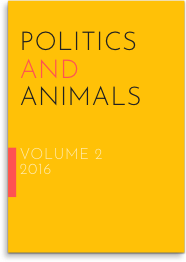Abstract
This study aims to identify determinants of animal protection policies. Based on a review of relevant literature and borrowing concepts from environmental policy research, we suggest three broad factors to be positively related with stricter animal protection policies: economic development, democracy, and civil society. To test the influences of these factors, we estimate an ordered logistic regression model to explain policy variations between 48 countries. As dependent variable we use the Animal Protection Index, a country ranking based on policy strictness. As independent variables we use GDP per capita, Polity Score, Civic Activism Index, and number of animal protection organizations. Results suggest that countries with stronger democratic institutions and more civil society groups focused on animal protection are likely to have stricter animal protection policies. For economic development and broad civil society strength we do not find significant effects. Our analysis broadens the basis for future research of more detailed policy determinants and cross-country differences in animal protection.
References
- Agresti, A. (1996). An introduction to categorical data analysis (Vol. 135). New York: Wiley.
- Caviglia-Harris, J. L., Chambers, D., & Kahn, J. R. (2009). Taking the "U" out of Kuznets: A comprehensive analysis of the EKC and environmental degradation. Ecological Economics, 68(4), 1149-1159. http://dx.doi.org/10.1016/j.ecolecon.2008.08.006
- Chemnitz, C. & Becheva, S. (Eds.). (2014). Meat atlas: Facts and figures about the animals we eat. Berlin: Heinrich Böll Foundation; Brussels: Friends of the Earth Europe.
- Dietz, T., Fitzgerald, A., & Shwom, R. (2005). Environmental values. Annual Review of Environment and Resources, 30(1), 335-372. http://dx.doi.org/10.1146/annurev.energy.30.050504.144444
- FAO (2013). Statistical Yearbook 2013: World Food and Agriculture. Rome: Food and Agriculture Organization of the United Nations.
- Fearon, J. D., & Laitin, D. D. (2003). Ethnicity, insurgency, and civil war. American Political Science Review, 97(1), 75-90. http://dx.doi.org/10.1017/S0003055403000534
- Fiorino, D. (2011). Explaining national environmental performance: approaches, evidence, and implications. Policy Sciences, 44(4), 367-389. http://dx.doi.org/10.1007/s11077-011-9140-8
- Frank, J. (2008). Is there an "animal welfare Kuznets curve?" Ecological Economics, 66(2-3), 478-491. http://dx.doi.org/10.1016/j.ecolecon.2007.10.017
- Fraser, D. (2008). Toward a global perspective on farm animal welfare. Applied Animal Behaviour Science, 113(4), 330-339. http://dx.doi.org/10.1016/j.applanim.2008.01.011
- Gallup, G. G. (1970). Chimpanzees: self-recognition. Science, 167(3914), 86-87.
- Gill, M., Smith, P., & Wilkinson, J. (2010). Mitigating climate change: the role of domestic livestock. Animal, 4(3), 323-333.
- Hart, R. A., & Clark, D. H. (1999). Does size matter? Exploring the small sample properties of maximum likelihood estimation. Paper presented at the Annual Meeting of the Midwest Political Science Association.
- IMF. (2014). World Economic Outlook Database. Retrieved 06/06/2015 from: https://www.imf.org/external/pubs/ft/weo/2014/02/weodata/index.aspx
- Irwin, P. G. (2003). A strategic review of international animal protection. In D. J. Salem & A. N. Rowan (Eds.), The state of the animals 2003 (pp. 1-8). Washington, DC: Humane Society Press.
- ISD. (2013). Indices of Social Development. Retrieved 07/06/2015 from: http://www.IndSocDev.org/
- Jones, R. C. (2013). Science, sentience, and animal welfare. Biology & Philosophy, 28(1), 1-30. http://dx.doi.org/10.1007/s10539-012-9351-1
- Kuznets, S. (1955). Economic growth and income inequality. The American Economic Review, 45(1), 1-28.
- Li, Q., & Reuveny, R. (2006). Democracy and environmental degradation. International Studies Quarterly, 50(4), 935-956. http://dx.doi.org/10.1111/j.1468-2478.2006.00432.x
- Lombardini, C., Kosenius, A.-K., Kulmala, S., & Lindroos, M. (2011). Is there a Finnish Animal Welfare Kuznets Curve? Paper presented at the EAAE 2011 Congress: Change and Uncertainty, Zurich.
- Long, J. S. (1997). Regression models for categorical and limited dependent variables. Thousand Oaks, CA: Sage.
- Louviere, J. J., Hensher, D. A., & Swait, J. D. (2000). Stated choice methods: Analysis and applications. Cambridge: Cambridge University Press.
- Marshall, M. G., & Jaggers, K. (2014). Polity IV Project, Political Regime Characteristics and Transitions, 1800-2014. Retrieved 09/06/2015 from: http://www.systemicpeace.org/inscrdata.html
- McFadden, D. (1973). Conditional logit analysis of qualitative choice behavior. In P. Zarembka (Ed.), Frontiers in Econometrics (pp. 105-142). New York: Academic Press.
- Morris, M. C. (2013). Improved nonhuman animal welfare is related more to income equality than it is to income. Journal of Applied Animal Welfare Science, 16(3), 272-293. http://dx.doi.org/10.1080/10888705.2013.768921
- O'Brien, R. M. (2007). A caution regarding rules of thumb for variance inflation factors. Quality & Quantity, 41(5), 673-690. http://dx.doi.org/10.1007/s11135-006-9018-6
- Proctor, H. (2012). Animal sentience: Where are we and where are we heading? Animals, 2(4), 628-639.
- Regan, T. (1983). The case for animal rights. Berkeley, CA: University of California Press.
- Rowan, A. N., & Rosen, B. (2005). Progress in animal legislation: measurement and assessment. In D. J. Salem & A. N. Rowan (Eds.), The state of the animals 2005 (pp. 79-94). Washington, DC: Humane Society Press.
- Singer, P. (1975). Animal liberation: a new ethics for our treatment of animals. New York: New York Review.
- Stern, D. I. (2004). The rise and fall of the Environmental Kuznets Curve. World Development, 32(8), 1419-1439. http://dx.doi.org/10.1016/j.worlddev.2004.03.004
- Taylor, K., Gordon, N., Langley, G., & Higgins, W. (2008). Estimate for worldwide laboratory animal use in 2005. Alternatives to Laboratory Animals, 36(3), 327-342.
- Trent, N., Edwards, S., Felt, J., & O'Meara, K. (2005). International animal law, with a concentration on Latin America, Asia, and Africa. In D. J. Salem & A. N. Rowan (Eds.), The state of the animals 2005 (pp. 65-77). Washington, DC: Humane Society Press.
- WAP. (2014). Animal Protection Index. Retrieved 21/05/2015, from http://api.worldanimalprotection.org/
- Wolfe, R., & Gould, W. (1998). An approximate likelihood-ratio test for ordinal response models. Stata Technical Bulletin, 7(42).
- WorldAnimalNet. (2015). WAN Directory. Retrieved 26/05/2015 http://worldanimal.net/directory/
- Yandle, B., Bhattarai, M., & Vijayaraghavan, M. (2004). Environmental Kuznets curves: a review of findings, methods, and policy implications. Property and Environment Research Center.

